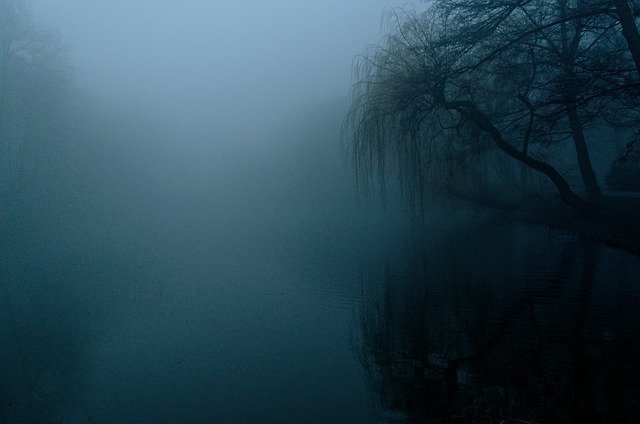
Lights are taken for granted. Even as they drown out the light from much, much larger celestial bodies burning and exploding far, far away, we are drawn to bright lights and big cities.
For some of us, too much light is a problem, but what about the opposite? What would happen if you were to fall into complete, perpetual darkness and never return?
We spoke with Dr. Karl Citek, an optometrist and professor of Optometry at Pacific University, to get some insight into this dark hypothetical.
When we think of light, we usually think in terms of color.
Sunlight and moonlight both look different to us because they each have an array of colors and properties that cause the objects around them to behave differently depending on what kind of color they are reflecting.
“Light has two components: Color, which is how you see something, and brightness, which is how much light is coming off of it.
You can have a red object that has more or less brightness than another object,” Citek said.
Human beings are able to see thanks to certain cells in our eyes with pigments sensitive to different colors.
These cells catch the light and send signals along nerve paths to our brains, which interpret the light’s color and send corresponding signals along other nerve paths to our brains telling us that we’re seeing something red.
The sky is blue because, in general, molecules in the air scatter sunlight (or moonlight) such that blue wavelengths are scattered off of it more than red or green ones.
If there were no scattering in the atmosphere, we’d see a yellowish-orange sky.
The full moon is much brighter than any stars in the sky because it’s closer than they are and reflects a lot of light from the sun.
Incidentally, this is why we can’t see stars during daylight hours, their light gets drowned out by sunlight before it has time to reflect and scatter.
What happens if you stay in the dark too long?
There are cells in our eyes called rods and cones. Rods detect brightness levels while cones detect color, but there are no cones in the retina that would see the light that’s outside of the visible spectrum.
“The only way to survive in complete darkness is to have a chemical or cellular adaptation,” Citek said. “Our eye has rod cells-cells that are sensitive in dim light.
They don’t see color, they just detect the brightness level in a room.”
The rod cells in our eyes have spooky superpowers. If your retina were exposed to direct sunlight, it would be damaged because the light coming in would be too bright for you to handle without eye protection.
But the rod cells in your eyes exist to handle this. They can detect very low levels of light and send a message quickly along a nerve path to tell your brain that there’s a small amount of light present.
This is why you can see an image clearly when you go from a dark room into the glowing, sunlit outdoors-when you first walk into the light, you see everything as if it were twilight.
However, your eyes quickly adjust to the difference in brightness levels and you can only see the sky as bright blue because that’s what color it is reflecting.
“If you are in complete darkness, the rod cells are still working. They still detect brightness at a subconscious level, but they won’t send the signal to your brain.
You’ll still have that subconscious image of what you’re seeing, whether it’s a bright light or not,” Citek said.
“It’s kind of like when you go on an airplane and there are no windows. Even if all the lights are out, you still know where you’re sitting in the plane.”
Citek believes that, based purely on this information, a person could never be completely blind.
Although rods and cones are responsible for vision during bright light and dim light respectively, there is a third cell type called a photoreceptor. This kind of cell only exists outside of our eyes-in our skin.
How long can a human stay in the dark?

For the longest time, no one had taken a research team and explored what happens to a person when he or she is in complete darkness. Citek and his team developed an experiment during which participants were deprived of light for up to 48 hours.
“The first night we did it was interesting because we didn’t know how people would react to it,” Citek said. “We wanted them to wear a toy Mickey Mouse helmet with four small red lights on the end of each arm, and we told them they couldn’t sleep during the first night.”
“They had no problems sleeping for eight hours (after that), but they were very restless the first night. They would wake up and try to turn on the lights, but if they did that, we had to start all over again.”
After one night of adjusting to complete darkness, participants were left in a completely dark room for 48 hours. The experiment caused them no physical harm; however, their mental states were put through some major changes.
“The first thing you notice is that you are very tired,” Citek said. “You’ll sleep about 12 hours the first night, but then it’s kind of like staying awake for two days straight.”
“After 24 hours, people start to get a little loopy and they will tell you all kinds of things that don’t make sense. If someone is crying for the first 12 hours, then they’ll be laughing hysterically after 24 hours.”
“The second night is harder because you know what to expect. You’ve already experienced the lack of light and lack of sleep, so it’s even more difficult than the first night.”
After 48 hours, participants were given a candle and allowed one hour of light to eat, read and do whatever they needed to do.
“After that hour, you’re back in the dark,” Citek said. “Most people will sit in a corner and just cry while they try to get their eyes used to the dark again.”
- Related post: What Would Happen If You Didn’t Get Your Sleep
- Related post: What Would Happen if Oxygen Were to Disappear
Why should we care?
The experiment shows how delicate our bodies are to changes in the environment.
“We know that too much light or too little light can cause problems with your circadian rhythm, but there is no exact number for how much light you need,” Citek said.
“All of our research points out that the human eye was made to detect brightness, not darkness.”
“You could go on vacation for a week and live completely in the dark, but you still have that photoreceptor in your skin that is constantly sending signals to your brain about how bright it is outside.”
While most people can adjust their circadian rhythm fairly easily, some cannot.
People who suffer from insomnia often find themselves lying awake at night because they are too bright or too dark.
“A lot of people don’t want to take the time to go out and buy really thick blinds for their bedroom because they’re too busy during the day,” Citek said.
“If you sleep in complete darkness, that’s actually better for your eyes than sleeping with your regular blinds or curtains.”
Conclusion
The human eye was designed to see, not darkness. In a completely dark room, it’s actually healthier to sleep with your eyes open than closed because the photoreceptor in our skin is constantly sending information about light into our brain.
Our bodies were made for movement and eating; we weren’t built to sit around idle in complete darkness. Luckily, our biological clocks are fairly easy to reset.
When Citek created the experiment, he expected people to have a harder time adjusting to complete darkness. However, they adjusted faster than he had imagined.
All it takes is one night of being awake in order for your body to adjust properly.
“It’s amazing how well the human body can adjust to its surroundings,” Citek said. “I’m glad that my living room isn’t completely dark because if it was, I would have to wear a blindfold every time I want to go inside.”
“My eyes will never be able to handle complete darkness.”



